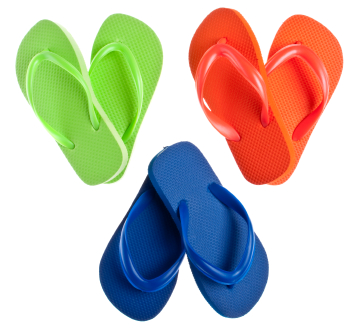(ARA) – Let’s face it – flip-flops are mainstream, and not just because they’re stylish, easy-to-wear and cooler when the weather warms. For many of us, flip-flops are the equivalent of comfort-food for the sole. Slip into those comfy, light, lovely shoes and you feel like summer really has arrived.
Yet if you’re prone to foot problems or concerned with overall foot health, you may shy away from one of summer’s great joys, believing flip-flops aren’t good for your feet. After all, 50 percent of Americans have experienced foot pain or discomfort at some point, and improper footwear is a leading cause, according to a survey by the American Podiatric Medical Association (APMA).
“Non-supportive flip-flops cause a common foot injury known as plantar fasciitis, an inflammation of the tissue along the bottom of the foot and the heel,” says podiatrist Phillip Vasyli, co-founder with integrative medicine expert Dr. Andrew Weil of Weil Integrative Footwear. “Flip-flops leave feet prone to common muscle overuse injuries, which can be easily prevented with the right footwear.”
The good news is, you can wear flip-flops-even if you never thought you could. It is possible to find stylish, good-looking varieties that feel great and are healthful for your feet. The APMA offers some tips for choosing flip-flops:
* Look for shoes, including flip-flops, that have earned the APMA’s Seal of Acceptance. This seal indicates the APMA considers the shoe to be one that promotes good foot health. Footwear like Orthaheel that carries the APMA seal has demonstrated its ability to provide proper support to feet.
* Choose a flip-flop that bends only at the ball of the foot. You shouldn’t be able to bend your flip-flop in half. Footwear like Weil Integrative Footwear that are designed with orthotics in mind provide balance, arch support and alignment for the feet.
* Look for flip-flops made of high-quality, soft leather for the thong and a sturdy, comfortable, supportive base.
* Choose flip-flops in the correct size so your toes or heels don’t hang off the edge of the sole.
* Replace last year’s worn flip-flops if they show signs of wear. Cracked or frayed shoes may cause foot irritation and provide inadequate support.
* Wear your supportive flip-flops and stylish, comfortable sandals at the pool, beach or for a fun evening dining al fresco. Save them for another time if you’re planning on doing yard work, playing sports or will be walking for a long time. Athletic shoes or supportive sandals make better choices for those occasions.
“From the integrative medicine approach, we’re always looking at simple, low-tech, noninvasive ways of improving health,” Weil says. “An obvious area in which to concentrate is designing really comfortable, effective footwear that can enable people to have an active lifestyle. Orthotics can bring preventative relief to many people and I commonly recommend them.”
To maintain your foot health, find a podiatrist at www.apma.org. For more information on supportive flip-flops and stylish sandals, see www.weilbeing.com and www.orthaheelusa.com.
This article was reprinted from: APMA enews
